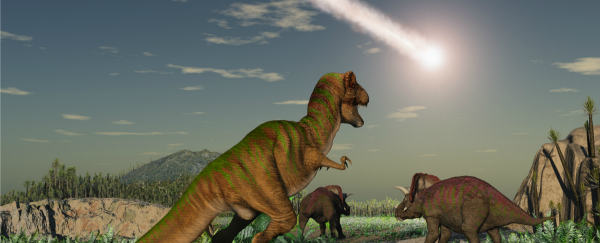A mind-blowing new paper suggests that dark matter could have triggered not just the extinction of the dinosaurs, but all other mass extinctions on the planet too. And, bear with us here because we know it sounds kind of far-fetched, but it actually makes a lot of sense.
Publishing in the Monthly Notices of the Royal Astronomical Society, Michael Rampino, a geoscientist at New York University in the US, explains that mass extinctions occur roughly ever 26 million to 30 million years on Earth - around the same time our Solar System passes through the disc of the Milky Way.
In the past, researchers have noticed this association, and suggested that perhaps clouds of dust and gas, and possibly even dark matter, in the Milky Way's plane might be somehow shaking comets off their orbits and causing them to slam into Earth, triggering these mass extinctions. But Rampino's hypothesis takes things one step further and suggests that dark matter could also trigger Earth-based events such as huge volcanic eruptions.
If true, the hypothesis could account for both extinctions as a result of extinction-causing disasters here on Earth, as well as asteroid or comet impacts - like the one that smashed into Mexico's Yucatán Peninsula and wiped out the dinosaurs roughly 66 million years ago.
"It's always been a mystery as to how extraterrestrial impacts could cause these long-lived geological effects," Rampino told Sid Perkins for Science magazine.
According to his hypothesis, dark matter could trigger all kinds of problems on Earth. Even though we still don't quite understand what dark matter is, researchers know that there's a lot of it out there in space (around 27 percent), because of its gravitational pull on other objects.
As Perkins explains in Science:
"Researchers estimate that in the plane of the galaxy, each square light-year contains about one solar mass of dark matter. Like the clouds of dust and gas that astronomers can see, clouds of dark matter may be perturbing the orbits of distant comets, causing them to fall into the inner solar system where they can strike Earth."
But the clouds could also have big impacts on Earth if they became trapped by our planet's gravity as our Solar System passes through the galactic plane.
These dark matter particles could then be stuck orbiting Earth before eventually falling to the planet's core, where they would interact with normal matter and each other and start releasing heat. This could raise the temperature of Earth's cores by hundreds of degrees Celsius, Rampino wrote in the new paper.
That heat could be eventually carried to Earth's surface via hot buoyant rock that could create volcanic hot spots, slowly rip apart continents or even alter the global climate so much that entire regions become uninhabitable, as Perkins explains.
Dennis Kent, a geophysicist at the Lamont-Doherty Earth Observatory in New York, who wasn't involved in the research, told Perkins that the hypothesis was intriguing. "One of those sources of environmental disruption might be tolerable," he explained to Perkins, but together he admitted that they could overload ecosystems and result in extinctions.
Of course, the evidence to support this hypothesis is obviously still lacking, but it's a pretty cool thing to think about. And if dark matter is causing mass extinctions on our planet, then we wonder if it's doing it to other planets too.
Source: Science
